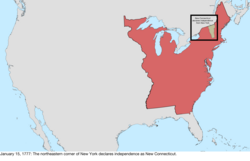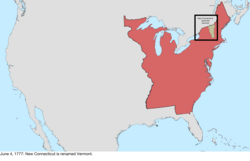The United States of America was formed after thirteen British colonies in North America declared independence from the British Empire on July 4, 1776. In the Lee Resolution, passed by the Second Continental Congress two days prior, the colonies resolved that they were free and independent states. The union was formalized in the Articles of Confederation, which came into force on March 1, 1781, after being ratified by all 13 states. Their independence was recognized by Great Britain in the Treaty of Paris of 1783, which concluded the American Revolutionary War. This effectively doubled the size of the colonies, now able to stretch west past the Proclamation Line to the Mississippi River. This land was organized into territories and then states, though there remained some conflict with the sea-to-sea grants claimed by some of the original colonies. In time, these grants were ceded to the federal government.

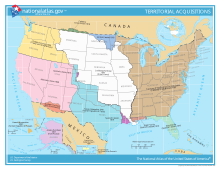

The first great expansion of the country came with the Louisiana Purchase of 1803, which doubled the country's territory, although the southeastern border with Spanish Florida was the subject of much dispute until it and Spanish claims to the Oregon Country were ceded to the US in 1821. The Oregon Country gave the United States access to the Pacific Ocean, though it was shared for a time with the United Kingdom.[2] The annexation of the Republic of Texas in 1845 led directly to the Mexican–American War, after which the victorious United States obtained the northern half of Mexico's territory, including what was quickly made the state of California.[3]
As the development of the country moved west, however, the question of slavery became more important, with vigorous debate over whether the new territories would allow slavery and events such as the Missouri Compromise and Bleeding Kansas. This came to a head in 1860 and 1861, when the governments of the southern states proclaimed their secession from the country and formed the Confederate States of America. The American Civil War led to the defeat of the Confederacy in 1865 and the eventual readmission of the states to the United States Congress. The cultural endeavor and pursuit of manifest destiny provided a strong impetus for westward expansion in the 19th century.
The United States began expanding beyond North America in 1856 with the passage of the Guano Islands Act, causing many small and uninhabited, but economically important, islands in the Caribbean Sea and the Pacific Ocean to be claimed.[4] Most of these claims were eventually abandoned, largely due to competing claims from other countries. The Pacific expansion culminated in the annexation of Hawaii in 1898, after the overthrow of its government five years previously. Alaska, the last major acquisition in North America, was purchased from Russia in 1867. Support for the independence of Cuba from the Spanish Empire, and the sinking of the USS Maine, led to the Spanish–American War in 1898, in which the United States gained Puerto Rico, Guam, and the Philippines, and occupied Cuba for several years. American Samoa was acquired by the United States in 1900 after the end of the Second Samoan Civil War.[5] The United States purchased the U.S. Virgin Islands from Denmark in 1917.[6] Puerto Rico and Guam remain territories, and the Philippines became independent in 1946, after being a major theater of World War II.
Following the war, many islands were entrusted to the U.S. by the United Nations,[7] and while the Northern Mariana Islands became a U.S. territory, the Marshall Islands, Federated States of Micronesia, and Palau emerged from the trust territory as independent nations. The last major international change was the acquisition in 1904, and return to Panama in 1979, of the Panama Canal Zone, an unincorporated US territory which controlled the Panama Canal. The final cession of formal control over the region was made to Panama in 1999.
States have generally retained their initial borders once established. Only three states (Kentucky, Maine, and West Virginia) have been created directly from area belonging to another state (although at the time of admission, Vermont agreed to a monetary payment for New York to relinquish its claim); all of the other states were created from federal territories or from acquisitions. Four states (Louisiana, Missouri, Nevada, and Pennsylvania) have expanded substantially by acquiring additional federal territory after their initial admission to the Union. In 1912, Arizona was the last state established in the contiguous United States, commonly called the "lower 48". In 1959, Hawaii was the 50th and most recent state admitted.
Legend for maps
- Key to map colors
- United States states (domestic maps), undisputed area of United States (dispute maps)
- United States territories (domestic maps)
- disputed area of United States
- area changed by event
1776–1784 (American Revolution)
| Date | Event | Change Map |
|---|---|---|
| July 4, 1776 | Thirteen colonies of the Kingdom of Great Britain in North America collectively declared their independence as the United States of America,[a] though several colonies had already individually declared independence:[8]
The capital was not specifically established; at the time, the Continental Congress met in Philadelphia.[25][26] Many states had vaguely defined and surveyed borders; these are not noted as contested in the maps unless there was an active dispute. The borders of North Carolina were particularly poorly surveyed, its border with South Carolina having been done in several pieces, none of which truly matched the spirit of the charter,[27][28] and its border with Virginia was only surveyed roughly halfway inland from the sea. Several northeastern states had overlapping claims: Connecticut, Massachusetts Bay, and New York all claimed land west of their accepted borders, overlapping with each other and with a sizable claim by Virginia. Of the three, only Connecticut seriously pursued its claims, while Virginia is considered to have had the most legitimate claim to the vast northwest, dividing it into counties and maintaining some limited control. The entirety of the new United States was claimed by Great Britain, including Machias Seal Island and North Rock, two small islands off the northeast coast which remain disputed up to the present.[29] | 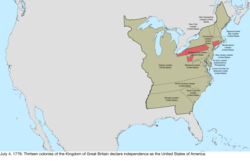 Disputes: |
| September 20, 1776 | The Counties of New Castle, Kent, and Sussex, upon Delaware enacted a constitution, renaming itself the Delaware State.[30] |  |
| September 28, 1776 | The State of Pennsylvania enacted a constitution, renaming itself the Commonwealth of Pennsylvania.[31] | no change to map |
| December 20, 1776 | To avoid British forces who were advancing on Philadelphia, the Continental Congress began meeting in Baltimore.[25][26] |  |
| January 15, 1777 | The northeastern region of New York, known as the New Hampshire Grants, declared independence as New Connecticut.[32][33][34] | Disputes: |
| March 4, 1777 | The Continental Congress returned to Philadelphia after the threat to it by British forces ended.[25][26] |  |
| June 4, 1777 | New Connecticut was renamed Vermont.[34][32] | Disputes: |
| September 27, 1777 | The Continental Congress fled Philadelphia after the American defeat at the Battle of Brandywine, and briefly met in Lancaster, Pennsylvania[25][26] | 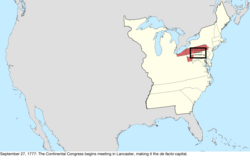 |
| September 30, 1777 | The Continental Congress continued to move away from Philadelphia, settling in York, Pennsylvania.[25][26] | 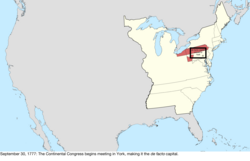 |
| June 11, 1778 | Vermont claimed what was called the "East Union", consisting of some towns in New Hampshire that petitioned on March 12, 1778, to join with Vermont due to a concern that their state was focusing too much on its coastal region. Vermont never gained full control over the area.[32][35][36][37][b] | Disputes: |
| October 21, 1778 | Due to pressure from the Continental Congress, Vermont rescinded the annexation of the East Union; the legislature declared on February 12, 1779, that the East Union should be considered null from its beginning.[35][36][37] | Disputes: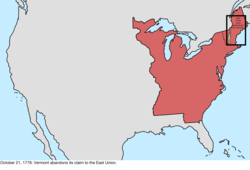 |
| July 2, 1779 | The Continental Congress returned to Philadelphia following British withdrawal.[25][26] |  |
| August 31, 1779 | Virginia surrendered its claim to southwest Pennsylvania.[20][38] |  |
| March 1780 | North Carolina and Virginia surveyed their border further inland. Virginia's survey reached to the Tennessee River, but North Carolina's only went as far as the Cumberland Gap, and as the two surveys were roughly two miles apart, this created a thin area claimed by both states. While the border was intended to follow 36°30′ north, early surveying errors caused it to veer north of that, reaching a distance of almost ten miles off by the time it reached the Tennessee River.[39][24] |  |
| October 25, 1780 | The State of Massachusetts Bay enacted a constitution, renaming itself the Commonwealth of Massachusetts. |  |
| March 1, 1781 | The Articles of Confederation entered into force.[40] | no change to map |
| April 4, 1781 | Vermont again claimed an East Union, consisting of some towns in New Hampshire that wished to join with Vermont; more towns were interested than during the first attempt in 1778, though again, the exact extent of the borders is unknown. Vermont never gained full control over the area.[32][41][36][37][c] | Disputes: |
| June 16, 1781 | Vermont claimed what was called the "West Union", consisting of some towns in New York, mainly to counterbalance Vermont's attempt at eastward expansion. Vermont never gained full control over the area.[32][36][42][43] The specific date this occurred is unclear; sources suggest June 16, June 26, and July 18.[d] | Disputes: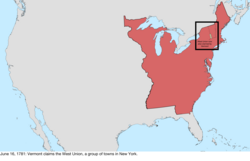 |
| February 22, 1782 | Vermont abandoned its attempts to annex the East Union from New Hampshire and the West Union from New York.[32][37][43][44] | Disputes: |
| October 29, 1782 | The federal government accepted the cession from New York of its western claims, which the state ceded on February 19, 1780, and executed on March 1, 1781; New York proclaimed its new western border to be a line drawn south from the western end of Lake Ontario. At its maximum interpretation, the state had claimed an area bounded by Lake Erie, Lake Huron and Lake Michigan; to the Illinois, Mississippi, and Tennessee Rivers; and north along the Appalachian Mountains, ending at the border with Pennsylvania.[45] It is unclear from where this claim came; many sources state that New York had surrendered it, but very few elaborate on how it was obtained. One source states that it was a cession by the Six Nations, who had conquered much of the region.[46] However, New York never seriously enforced these claims. The cession included the small tip of New York north of Pennsylvania, which came to be known as the Erie Triangle.[47][18] |  |
| December 30, 1782 | The Congress of the Confederation declared that the land that Connecticut claimed in northern Pennsylvania was part of Pennsylvania, thus attempting to end the Pennamite–Yankee War.[48][20] The claim was an extension of Connecticut's northernmost and southernmost borders westward, skipping New Jersey and New York, though as Connecticut's northern border was a few miles north of Pennsylvania's northern border, a small sliver of New York was also claimed. While conflict would continue for some time, this was the end of the formal claim by Connecticut. |  |
| June 30, 1783 | The Pennsylvania Mutiny of 1783, and the Pennsylvania government reaction to it, caused the Congress of the Confederation to leave Philadelphia for Princeton.[25] | 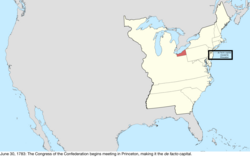 |
| November 26, 1783 | The Congress of the Confederation reconvened in Annapolis.[25] |  |
| March 1, 1784 | Virginia ceded its claims northwest of the Ohio River to the federal government.[49][24] Connecticut continued to claim its western lands that had overlapped with Virginia's cession. |  |
| May 12, 1784 | Great Britain recognized the independence of the United States, ending its claim to the country.[50][51][e] The treaty ended the American Revolutionary War, though military action had largely ended after the Franco-American victory at Yorktown on October 19, 1781. Because of ambiguities and poor knowledge of geography, the treaty was unclear in several areas:
The Peace of Paris also involved treaties with France and Spain, with Great Britain ceding the Floridas to Spain. During their ownership of West Florida, the British had moved its border north, and the cession to Spain appeared to apply to the full extent of the British colony. However, the British-American treaty granted the extension of West Florida to the United States, where it enlarged Georgia south to 31° north, indicating that only the original definition of West Florida was to be ceded to Spain. The local Spanish governors also made a move to occupy forts along the Mississippi River, with claims to everything south of the Tennessee River; it is unknown how official or strong these claims were, and they are not mapped as they are in conflict with the other Spanish claim involving the border of West Florida.[52] |  Disputes:  |
1784–1803 (Organization of territory)
| Date | Event | Change Map |
|---|---|---|
| August 23, 1784 | A region in central North Carolina (modern-day eastern Tennessee), unhappy with the state's governance over the area, declared independence from the state as the State of Frankland.[f][53] The government of Frankland held some control over the area, and petitioned for statehood, receiving support from seven of the nine states required, but would only last a few years.[54][55] | Unofficial change: |
| November 1, 1784 | The Congress of the Confederation moved for a short time to Trenton.[25] | 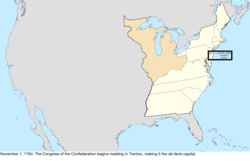 |
| January 11, 1785 | The Congress of the Confederation moved to New York, and would settle there for five years.[25] | 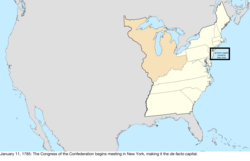 |
| April 19, 1785 | The federal government accepted the cession from Massachusetts of its extreme western claim, which was never seriously enforced.[g][45][14] | Change on paper only: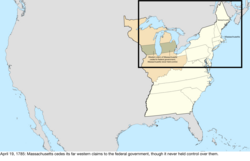 |
| June 1785 | The State of Frankland was renamed the State of Franklin, to encourage Benjamin Franklin to endorse the state, though he declined.[54] | Unofficial change: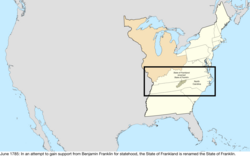 |
| September 13, 1786 | Connecticut surrendered its western claim to the federal government except for its Western Reserve, though it is unclear how much control they held over the ceded region.[h][9][56] | Change on paper only: |
| December 16, 1786 | Massachusetts surrendered its claim to western New York, though it is unclear if Massachusetts ever held control over the region, as the claim was to the "soil, not the sovereignty".[i][45][14] This land was later known as the Phelps and Gorham Purchase. | Change on paper only: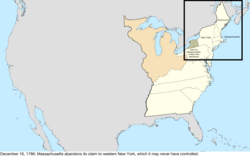 |
| July 13, 1787 | The Territory Northwest of the River Ohio, ceded earlier by Virginia, was organized and commonly became known as the Northwest Territory.[57][58] |  |
| August 9, 1787 | South Carolina ceded its western claim to the federal government,[59][23] though it was a result of inaccurate geography and South Carolina never actually held claim to this land. The claim was of a strip of land between the border of North Carolina and the source of the Tugaloo River but, unknown at the time, the river originated in North Carolina. The eastern part of this cession would be given to Georgia in 1802, despite Georgia technically already having claim to the land.[60] | Change on paper only: |
| December 7, 1787 | Delaware became the first state to ratify the United States Constitution.[61] | no change to map |
| December 12, 1787 | Pennsylvania became the second state to ratify the Constitution.[62] | no change to map |
| December 18, 1787 | New Jersey became the third state to ratify the Constitution.[63] | no change to map |
| January 2, 1788 | Georgia became the fourth state to ratify the Constitution.[64] | no change to map |
| January 6, 1788 | Connecticut became the fifth state to ratify the Constitution.[65] | no change to map |
| February 6, 1788 | Massachusetts became the sixth state to ratify the Constitution.[66] | no change to map |
| April 28, 1788 | Maryland became the seventh state to ratify the Constitution.[67] | no change to map |
| May 23, 1788 | South Carolina became the eighth state to ratify the Constitution.[68] | no change to map |
| June 21, 1788 | New Hampshire became the ninth state to ratify the Constitution;[69] at this point, the Constitution became the active governing document of those nine states having ratified the same (per Article VII). | no change to map |
| June 25, 1788 | Virginia became the tenth state to ratify the Constitution.[70] | no change to map |
| July 26, 1788 | New York became the eleventh state to ratify the Constitution.[71] | no change to map |
| February 1789 | John Sevier, governor of the State of Franklin, pledged allegiance to North Carolina, effectively ending the claimed independence of Franklin.[54][72] | Unofficial change: |
| August 7, 1789 | The Northwest Territory was reorganized under the Constitution.[73] | no change to map |
| November 21, 1789 | North Carolina became the twelfth state to ratify the Constitution.[74] | no change to map |
| April 2, 1790 | North Carolina ceded its western half to the federal government.[j][75][55] | 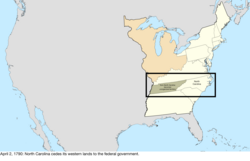 |
| May 26, 1790 | The land recently ceded by North Carolina was organized as the Territory South of the River Ohio, commonly known as the Southwest Territory.[55][76] | 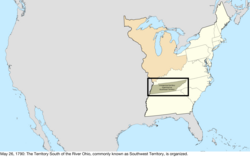 |
| May 29, 1790 | Rhode Island became the thirteenth state to ratify the Constitution.[77] | no change to map |
| December 6, 1790 | Per the Residence Act, the Congress of the United States relocated to Philadelphia for ten years until a federal district was built and ready.[25][26][78] |  |
| March 4, 1791 | Vermont, which had been considered part of New York despite acting independently since 1777, was admitted as the fourteenth state.[k][32][79] |  Disputes:  |
| March 30, 1791 | The District of Columbia, a federal district planned to house the federal government by 1800, was formed from land ceded by Maryland and Virginia,[80][81] consisting of a 100 square mile diamond, with its southern tip at Jones Point, straddling the Potomac River. However, it was not yet given that name, being simply referred to as the federal district. In September 1791, the commissioners in charge of planning the city would term it the "Territory of Columbia", and various laws refer to a District of Columbia, but sometimes informally. The area does not appear to have been formally named "District of Columbia" until at least the organic act of 1871.[82] Since the name "Columbia" was used from very early on, and at least informally by the government, the map will use "District of Columbia" starting from this date. | 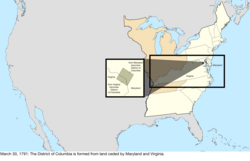 |
| March 3, 1792 | Pennsylvania purchased the Erie Triangle from the federal government.[20] | 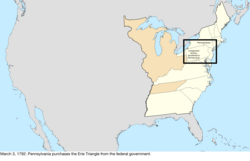 |
| June 1, 1792 | The western half of Virginia, which the state had agreed in 1789 to cede to the federal government,[83] was admitted as the fifteenth state, Kentucky.[l][85][84] |  |
| June 12, 1792 | The Delaware State enacted a new constitution, renaming itself the State of Delaware.[86] | no change to map |
| August 3, 1795 | Representatives of the United States and the Western Confederacy sign the Treaty of Greenville, ending the Northwest Indian War and ceding most of the modern state of Ohio to United States control.[87] | no change to map |
| February 29, 1796 | Great Britain agreed to abandon several forts in the northwest that it still occupied, including Detroit. The Jay Treaty also provided for commissions to determine the border between the northwestern point of the Lake of the Woods and the source of the Mississippi River, and which river to consider the St. Croix River.[88] | no change to map |
| April 25, 1796 | The northern half of West Florida was ceded by Spain, resolving the dispute over the region.[89][90] | Disputes: |
| June 1, 1796 | The Southwest Territory was admitted as the sixteenth state, Tennessee.[55][91] | 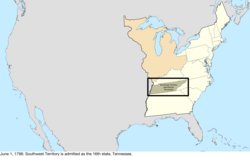 |
| April 7, 1798 | Due to the Yazoo Land Fraud, an act authorized President John Adams to appoint commissioners to negotiate with Georgia about ceding its western land. The act created Mississippi Territory from the southwestern quarter of Georgia in the region recently ceded by West Florida, while maintaining that Georgia still held rights over the territory.[92][93] |  |
| October 25, 1798 | Commissioners agreed on the source of the St. Croix River, setting the lower portion of the border between Massachusetts and Great Britain and, thus, where the eastern north–south line originated.[94] | 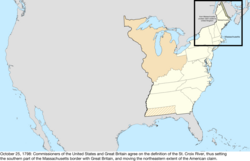 Disputes: 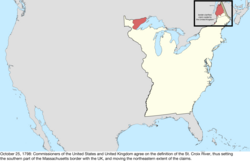 |
| June 9, 1800 | Connecticut ceded its Western Reserve to the federal government, which assigned it to the Northwest Territory.[95] The act doing so was passed in Congress on April 28, 1800, and Connecticut approved it on this date.[96] |  |
| July 4, 1800 | Indiana Territory was organized from the western half of Northwest Territory.[m][98][97] |  |
| November 17, 1800 | The Congress of the United States moved to Washington in the District of Columbia, now built and ready to be the capital.[25] This was two weeks before the December 1 date established in the Residence Act; President John Adams urged Congress to move early in hopes of securing enough Southern votes to be re-elected, though this failed.[99] |  |
| January 1, 1801 | The Kingdom of Great Britain united with the Kingdom of Ireland, renaming itself the United Kingdom.[100] |  |
| February 27, 1801 | The District of Columbia was organized.[81][101] | no change to map |
| April 26, 1802 | Georgia ceded its western half, known as the Yazoo Lands, to the federal government.[n] At the same time, the federal government ceded to Georgia the eastern portion of the land previously ceded by South Carolina, though in reality Georgia technically already held title to the land, as the description of the earlier cession was based on an erroneous understanding of geography.[12] |  |
| March 1, 1803 | The southern half of the Northwest Territory, along with a thin sliver of Indiana Territory, was admitted as the seventeenth state, Ohio. The remainder of the Northwest Territory was transferred to Indiana Territory.[102][57] The western border was a line due north from the mouth of the Great Miami River; the federal definition of the northern border was a line drawn east from the southern tip of Lake Michigan, whereas the Ohio Constitution stated the line should run from the southern tip of Lake Michigan to the most northerly cape of Maumee Bay, essentially the western tip of Lake Erie. The confusion caused by these varying descriptions of the state's borders, combined with inaccurate knowledge of geography, as no one at the time knew just how far south Lake Michigan extended, would lead to the conflict over the Toledo Strip. |  |
| November 3, 1803 | The border between Tennessee and Virginia was resurveyed and established, ending the dispute over that part of the border. The border between Kentucky and Tennessee, despite following the original survey, remained vaguely defined.[39][103] |  |
| November 30, 1803 | The "Southwick Jog" was transferred from Connecticut to Massachusetts, to put to rest long-standing disagreements over the border between the two states.[14] The final report of the commissioners was delivered this day;[104] it is unclear when the change formally occurred. |  |
1803–1818 (Purchase of Louisiana)
| Date | Event | Change Map |
|---|---|---|
| December 20, 1803 | The United States purchased Louisiana from France. This is the date of the formal turnover in New Orleans; the purchase was completed on April 30, 1803.[105] The transfer would be recognized in St. Louis in Upper Louisiana on March 10, 1804, known as Three Flags Day. The acquisition expanded the United States to the whole of the Mississippi River basin,[o] but the extent of what constituted Louisiana in the south was disputed with Spain: the United States claimed the purchase included the part of West Florida west of the Perdido River, whereas Spain claimed it ended at the western border of West Florida;[p][106] and the southwestern border with New Spain was disputed, as the United States claimed the Sabine River as the border, but Spain maintained it was the Calcasieu River and others.[105] | 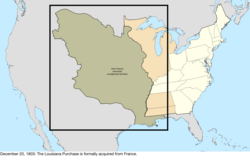 Disputes: |
| March 27, 1804 | The land between Tennessee and Mississippi Territory previously ceded by Georgia was assigned to Mississippi Territory.[93][107] |  |
| October 1, 1804 | Orleans Territory was organized from the Louisiana Purchase south of 33° north, with the remainder being designated the District of Louisiana and placed under the jurisdiction of Indiana Territory.[108][109] |  |
| June 30, 1805 | Michigan Territory was organized from Indiana Territory, north of a line east from the southern tip of Lake Michigan, and east of a line north from the lake's northern tip.[110][111] The southeastern portion of the border technically conflicted with the definition of Ohio, which claimed the Toledo Strip north of that line; however, the exact position of Lake Michigan was not yet known. | 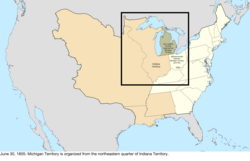 |
| July 4, 1805 | The District of Louisiana was organized as Louisiana Territory.[109][112] |  |
| March 1, 1809 | Illinois Territory was organized from the western half of Indiana Territory.[q][114][113] |  |
| September 26, 1810 | The Republic of West Florida declared independence from Spain, claiming the area of West Florida west of the Perdido River. It maintained some control over its territory.[115] | Disputes: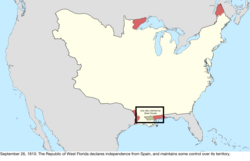 |
| December 10, 1810 | Armed forces led by William C. C. Claiborne took possession of the portion of West Florida west of the Pearl River, following a proclamation on October 27, 1810, by President James Madison to do so. The United States had considered the region part of the Louisiana Purchase, including the area which had revolted against Spanish Florida and formed the Republic of West Florida. Madison's proclamation stated that it was to be "taken as part" of Orleans Territory.[106][105][116] The land west of Mobile Bay to the Pearl River was occupied and annexed de facto by the military in 1811.[117]: 2a (map) | Disputes: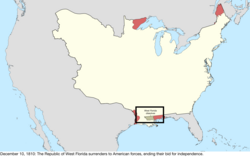 |
| April 30, 1812 | Most of Orleans Territory was admitted as the eighteenth state, Louisiana.[r][109][118] The southeastern remainder presumably became unorganized territory, as it had no definition for a short time. | 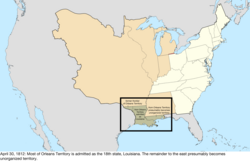 |
| May 14, 1812 | The claimed portion of West Florida east of the Pearl River was assigned to Mississippi Territory, though the area around Mobile Bay remained under the control of Spanish Florida.[93][119] The United States militarily occupied Mobile and the surrounding area up to the Perdido River in April 1813. |  |
| June 4, 1812 | Since its name was now shared with the state of Louisiana, Louisiana Territory was renamed Missouri Territory.[120][121] | 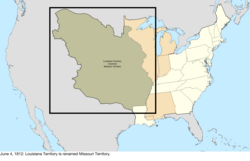 |
| August 4, 1812 | The remaining claimed portion of West Florida, west of the Pearl River, was added to Louisiana, following the assent of that state to an act passed by Congress on April 14, 1812.[122][123] |  |
| August 16, 1812 | During the War of 1812, the garrison at Fort Detroit surrendered, leading the United Kingdom to occupy Detroit, the capital and population center of Michigan Territory.[124] | Disputes: |
| September 29, 1813 | The British withdrew from Fort Detroit following the Battle of Lake Erie, allowing American forces to regain control over Michigan Territory.[124][125] | Disputes: |
| August 24, 1814 | British forces capture and burn Washington, but are forced to withdraw the next day. The functions of the capital were only momentarily suspended, though President James Madison took refuge in Brookville, Maryland.[126] | no change to map |
| December 11, 1816 | The southern part of Indiana Territory, along with small parts of Illinois Territory and Michigan Territory, were admitted as the nineteenth state, Indiana.[s] The remainder of Indiana Territory across Lake Michigan became unorganized territory.[97][127] | 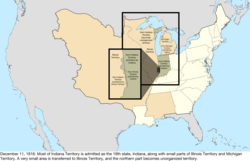 |
| March 3, 1817 | Alabama Territory was organized from the eastern half of Mississippi Territory.[t][129][128] | 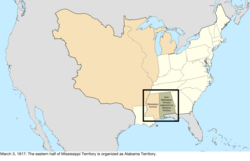 |
| December 10, 1817 | Mississippi Territory was admitted as the twentieth state, Mississippi.[93][130] | 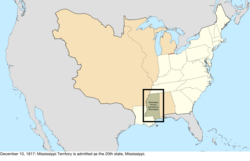 |
| February 6, 1818 | Alabama Territory created Tuskaloosa County with a description that inadvertently overlapped with Mississippi. It described the border of the county as running "a due west course to, the Tombeckbe river; thence up the same to the Cotton Gin Port".[131] Unknown at the time, the origin of the Tombigbee River and Cotton Gin Port were in Mississippi. | Change on paper only: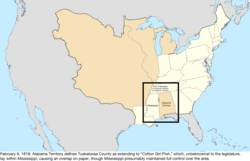 |
| June 30, 1818 | Per the terms of the Treaty of Ghent ending the War of 1812, the United Kingdom returned Moose Island to Massachusetts, and the United States returned Campobello Island, Deer Island, and Grand Manan Island to the United Kingdom, all of which were captured from the other side during the war.[132] | no change to map |
| December 3, 1818 | The half of Illinois Territory south of 42°30′ north was admitted as the twenty-first state, Illinois. The remainder of the territory, along with the unorganized territory that was recently part of Indiana Territory, was assigned to Michigan Territory.[113][133] | 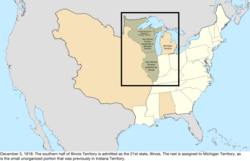 |
1819–1845 (Northwest expansion)
| Date | Event | Change Map |
|---|---|---|
| January 30, 1819 | The Treaty of 1818 went into effect, setting 49° north as the border with the United Kingdom west of the Lake of the Woods, and also establishing the Oregon Country as a shared region with the United Kingdom.[2][134][135] Oregon Country had no defined northern limit, but it can be assumed that it did not encroach much upon Russian-held lands; this map uses the later-established line at 54°40′ north for simplicity. |  Northwestern North America:  |
| July 4, 1819 | Arkansaw Territory was organized from the southern slice of Missouri Territory.[u][136][137] | 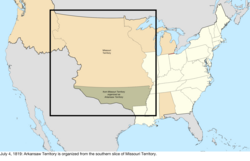 |
| December 14, 1819 | Alabama Territory was admitted as the twenty-second state, Alabama.[128][138] The statehood act provided for a survey of the southern part of the border with Mississippi, which was intended to be north–south, for adjustment if it was discovered to encroach upon Mississippi's established counties; it was later discovered to do so. | 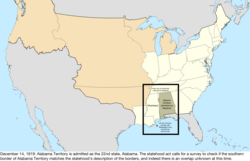 |
| March 15, 1820 | As part of the Missouri Compromise, the District of Maine, the northern and separate part of Massachusetts, was admitted as the twenty-third state, Maine.[139][140] |  |
| April 21, 1820 | This is the earliest known date of the name "Arkansas Territory" being officially used instead of "Arkansaw Territory".[141] |  |
| May 12, 1820 | The border between Kentucky and Tennessee was established. To make up for the fact that the border between the Cumberland Gap and the Tennessee River veered north as much as almost 10 miles from 36°30′ north, a new survey was conducted starting at that latitude on the Mississippi River and moving east to the Tennessee River, hence guaranteeing this last bit of border would fit the original ideal.[39] | 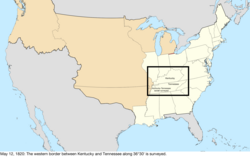 |
| July 19, 1820 | The overlap of the longitudinal southern border between Alabama and Mississippi was resolved, as per the act admitting Alabama as a state, because the provisional border encroached on Mississippi.[128][142] As the result of a survey, the southern border terminus was moved about 3.8 miles to the east, which changed the border up to the then-northwest corner of Alabama's Washington County. The date when this happened is unclear; the sources available give either an unpublished report dated May 29, 1820, or the completion of the demarcation of the new line on July 19, 1820. | Change on paper only: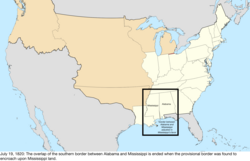 |
| December 19, 1820 | Alabama redefined some county borders, ending its erroneous overlap of Mississippi created on February 6, 1818.[143] | Change on paper only: |
| February 22, 1821 | The Adams–Onís Treaty with Spain took effect.[106] The many changes included:
|  Disputes: 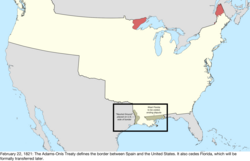 |
| July 10, 1821 | East Florida was formally transferred to the United States by Spain.[144] |  |
| July 17, 1821 | West Florida was formally transferred to the United States by Spain.[144] |  |
| August 10, 1821 | The southeastern corner of Missouri Territory was admitted as the twenty-fourth state, Missouri, the rest becoming unorganized territory.[w][121][145] | 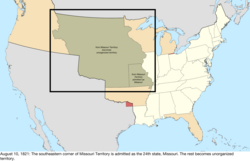 |
| March 30, 1822 | The former East Florida and West Florida were organized as Florida Territory.[146][147] |  |
| May 26, 1824 | The half of Arkansas Territory west of a line south from a point 40 miles west of Missouri's western border was returned to unorganized territory.[137][148] |  |
| January 12, 1825 | A treaty with the Russian Empire established 54°40′ north as the northern border of Oregon Country for American purposes; a separate treaty created the same border between Russia and the United Kingdom.[149] As this was likely the de facto border anyway, the region is already mapped with this line. | no change to map |
| May 6, 1828 | A treaty with the Cherokee moved the western border of Arkansas Territory, returning part of it to unorganized territory.[x][137][151] | 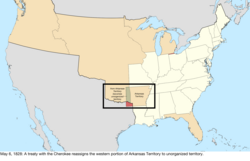 |
| January 20, 1831 | King William I of the Netherlands, having been asked per the Treaty of Ghent to arbitrate the disputed border between Maine and the United Kingdom, rendered his decision: since reconciling the treaty with the maps given was too difficult, he drew a compromise line. The British government accepted it, but Maine protested, and on January 19, 1832, the American government rejected it.[152] | no change to map |
| July 9, 1832 | The region of New Hampshire north of the Connecticut Lakes, which was disputed with the United Kingdom, declared independence as the Republic of Indian Stream.[153] While tiny, it does appear to have maintained some control over its territory. | Disputes: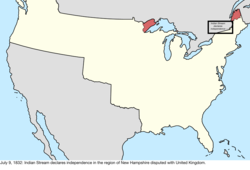 |
| June 28, 1834 | Michigan Territory gained a large parcel of land from unorganized territory, extending west to the Missouri River and White Earth River.[111][154] | 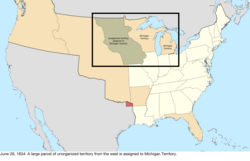 |
| August 5, 1835 | The Republic of Indian Stream recognized the jurisdiction of New Hampshire, thus ending its claimed independence. The date given is of a communication sent to British authorities;[155] other sources note a resolution passed by the citizens of Indian Stream on April 2, 1836.[153] | Disputes: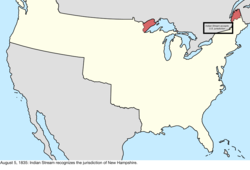 |
| June 15, 1836 | Arkansas Territory was admitted as the twenty-fifth state, Arkansas.[137][156] |  |
| July 3, 1836 | Wisconsin Territory was organized from the western bulk of Michigan Territory.[y][157][158] The two large peninsulas between the Great Lakes remained in Michigan Territory; the upper peninsula was included in exchange for the territory abandoning its claim to the Toledo Strip. The territory initially rejected this plan, but would accept it on December 14. | 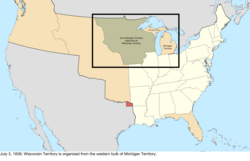 |
| December 14, 1836 | Michigan Territory agreed to abandon its claim to the Toledo Strip, ending its dispute with Ohio.[159] |  |
| January 26, 1837 | Michigan Territory was admitted as the twenty-sixth state, Michigan.[111][160] |  |
| March 28, 1837 | The Platte Purchase, obtained from several nations including the Potawatomi, Ioway, Missouria, Otoe, and Sac and Fox,[161] transferred some land from unorganized territory to northwest Missouri, extending its northern border west to the Missouri River.[121][162] | 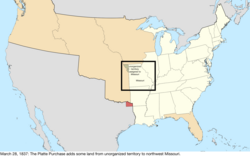 |
| July 3, 1838 | Iowa Territory was organized from Wisconsin Territory west of the Mississippi River.[163][164] |  |
| February 11, 1839 | Missouri claimed an area north of its border with Iowa Territory, initiating the long dispute known as the Honey War.[165] |  |
| May 21, 1840 | Surveying conducted along the border with Texas concluded that the area claimed by Arkansas for Miller County belonged to Texas.[166] |  |
| November 10, 1842 | The Webster–Ashburton Treaty defined the border with the United Kingdom east of the Rocky Mountains.[167][168] One source also mentions it very slightly altering the maritime boundary between Michigan and Wisconsin Territory.[169] The treaty resolved the disputes over the northern borders of Maine and New Hampshire,[z] the northeastern border of Wisconsin Territory,[aa] and Sugar Island with Michigan. The border between New York and Vermont on the one side, and the United Kingdom on the other, was clarified by the treaty. In 1816, construction began on an unnamed fort nicknamed "Fort Blunder" on a peninsula in Lake Champlain that, while south of the surveyed border, was discovered to be north of 45° north, which was the border set by the Treaty of Paris and thus in British territory. Consequently, construction on the fort was abandoned. The Webster–Ashburton Treaty specified that section of the border was to follow the surveyed line, rather than the exact parallel, thus moving the fort's area into the United States, and a new fort, Fort Montgomery, would be built on the spot in 1844.[171] As the earlier line was surveyed, even though it did not match the definition, it was deemed to be the legitimate border. |  Disputes:  |
| July 5, 1843 | Local settlers created a provisional government for Oregon Country. While not official, it did maintain some jurisdiction over the area.[172] | Unofficial change:  |
| March 3, 1845 | Florida Territory was admitted as the twenty-seventh state, Florida.[147][173] |  |
1845–1860 (Southwest expansion)
| Date | Event | Change Map |
|---|---|---|
| December 29, 1845 | The Republic of Texas was annexed and admitted as the twenty-eighth state, Texas, extending the United States southwest to the Rio Grande.[174][175] All of Texas was claimed by Mexico. While many sources state that Mexico recognized the independence of the eastern portion of Texas, the treaties were rejected by the Mexican government. Texas formally handed over sovereignty to the United States in a ceremony on February 19, 1846.[176] The annexation led to the beginning of the Mexican–American War a few months later.[176] |  Disputes:  |
| June 15, 1846 | The Oregon Treaty established 49° north west of the Lake of the Woods as the continental border (so it did not include Vancouver Island) with land held by the United Kingdom. The sharing of Oregon Country ended, and the United States portion became unorganized territory.[177] The treaty was vague on which strait should be the border between Vancouver Island and the continent, thus causing a dispute over ownership of the San Juan Islands.[178] It specified "through the middle of the said channel and of Fuca Straits, to the Pacific Ocean". | 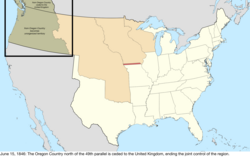 Northwestern North America:  Disputes:  |
| September 22, 1846 | Following the capture on August 18, 1846, of Santa Fe, the capital of the Mexican territory of Santa Fe de Nuevo México,[179] a code of laws known as the Kearny Code was created for the area.[180][181] The region overlapped with Texas' claim, though Texas had little to no control over the area outside of its eastern quarter. | Unofficial change: |
| December 28, 1846 | The portion of Iowa Territory south of 43°30′ north and east of the Big Sioux River was admitted as the twenty-ninth state, Iowa. The remainder became unorganized territory.[164][182] | 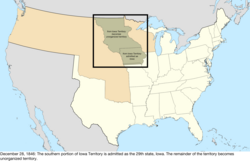 |
| March 13, 1847 | The District of Columbia retroceded Alexandria County back to Virginia.[81] Congress passed the act on July 9, 1846,[183] residents of Alexandria County were proclaimed by the president to have agreed to it on September 7, 1846,[184] and Virginia took possession of the land on this date.[185] |  |
| May 29, 1848 | The southern bulk of Wisconsin Territory was admitted as the thirtieth state, Wisconsin.[ab] The remainder became unorganized territory.[158][186] However, the citizens of the remainder decided to continue on with a civil government, and even elected a delegate to the United States House of Representatives who would be seated on January 15, 1849, essentially making this region a de facto continuation of Wisconsin Territory.[187] | 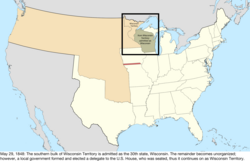 |
| July 4, 1848 | The Treaty of Guadalupe Hidalgo ended the Mexican–American War and ceded a large parcel of land from Mexico, consisting of its territories of Alta California and Santa Fe de Nuevo México, and its claim to Texas.[ac][189] Due to a disagreement over the southern border of Santa Fe de Nuevo México, a border dispute began.[188] | 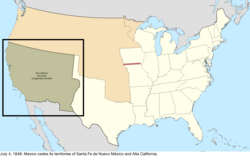 Disputes:  |
| August 14, 1848 | Oregon Territory was organized from the unorganized territory that was formerly part of Oregon Country.[190][191] |  |
| February 13, 1849 | The boundary dispute between Iowa and Missouri known as the Honey War was resolved by the Supreme Court of the United States. The resulting border was the Sullivan Line that existed before the dispute, roughly splitting the two claims.[192] |  |
| March 3, 1849 | Minnesota Territory was organized from the region that had been operating as de facto Wisconsin Territory, and unorganized territory east of the Missouri and White Earth Rivers.[193][170] |  |
| March 12, 1849 | A local government formed the State of Deseret and claimed a vast portion of the southwest, including most of the Mexican Cession. Though it petitioned to be admitted to the United States, the proposal was rejected and, in 1850, Utah Territory was formed instead.[194] The claimed area overlapped slightly with Texas' claimed area, as well as part of Oregon Territory. | Unofficial change: |
| November 24, 1849 | Texas, with consent from the United States Congress,[195] extended its border with Louisiana from the west bank of the Sabine River to the middle of the river.[195][196][197][198] | no change to map |
| September 9, 1850 | The western portion of the Mexican Cession was admitted as the thirty-first state, California.[ad][3][199] The portion of the remainder north of 37° north and west of the summit of the Rocky Mountains was organized as Utah Territory.[200][201] Part of Utah Territory overlapped with the portion of Texas that would be purchased on December 13, 1850, but the law authorizing the purchase was passed on this day, so the borders of Utah Territory assumed that the purchase would go through. | 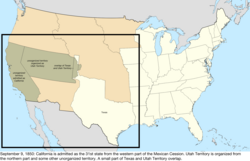 |
| December 9, 1850 | The United Kingdom ceded less than one acre of underwater rock for a lighthouse in Lake Erie near Buffalo, New York; although it was on Middle Reef, it was named for the nearby Horseshoe Reef.[202] It was surrounded by British waters, thus creating a form of enclave.[203] | 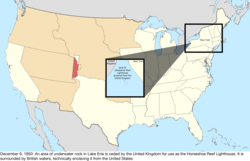 |
| December 13, 1850 | The federal government purchased the western claims of Texas.[ae][175] New Mexico Territory was organized from the part of this land east of the Rio Grande, along with the remaining unorganized territory from the Mexican Cession.[af][205][204] New Mexico Territory included all of the area that had been governed under the Kearny Code. |  |
| April 5, 1851 | The State of Deseret dissolved itself, its functions and territory largely having been superseded by Utah Territory.[206] | Unofficial change: |
| March 2, 1853 | Washington Territory was organized from the half of Oregon Territory north of 46° north and the Columbia River.[207][208] |  |
| May 30, 1854 | Kansas Territory was organized from unorganized territory north of 37° north, and Nebraska Territory was organized north of 40° north.[209][210][211] Much of the remaining unorganized territory, east of 100° west, became known as Indian Territory, designated as a place to resettle Indian tribes. A small strip between the Texas Panhandle and Kansas Territory was unclaimed, due to falling south of Kansas Territory's border but north of 36°30′ north established in the Missouri Compromise as the northern limit of slavery, and thus Texas could not have it. This became known as the Public Land Strip, or sometimes "No Man's Land".[212] | 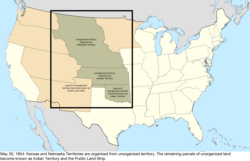 |
| June 30, 1854 | The United States purchased a large parcel from Mexico known as the Gadsden Purchase, as it offered a much better route for a southern transcontinental railroad.[ag][213][214] This resolved the border dispute, since the disputed land was included in the purchase.[188] | 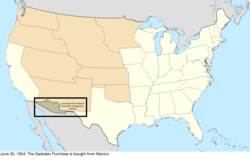 Disputes: 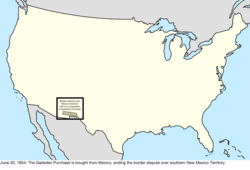 |
| August 4, 1854 | The recently obtained Gadsden Purchase was assigned to New Mexico Territory.[204][215] |  |
| January 11, 1855 | Due to its inaccessibility from the rest of the state, Boston Corner was transferred from Massachusetts to New York.[216][217][218] |  |
| March 6, 1855 | The Supreme Court ruled in favor of Florida in a boundary dispute with Georgia, setting the state boundary line along McNeil's line.[219] | no change to map |
| October 28, 1856 | Baker Island and Jarvis Island were claimed under the Guano Islands Act.[4] | Pacific Ocean: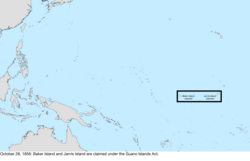 |
| May 11, 1858 | The eastern half of Minnesota Territory was admitted as the thirty-second state, Minnesota.[ah] The remainder became unorganized territory.[170][220] |  |
| August 31, 1858 | Navassa Island was claimed under the Guano Islands Act.[4] | Caribbean Sea: |
| December 3, 1858 | Howland Island was claimed under the Guano Islands Act.[4] | Pacific Ocean: |
| February 14, 1859 | The western half of Oregon Territory was admitted as the thirty-third state, Oregon.[ai] The remainder was transferred to Washington Territory.[191][221] |  |
| July 6, 1859 | A team of surveyors created the "Middleton Offset", a small notch in the border between Kentucky and Tennessee. It is unknown exactly why this was done, though one theory is a local landowner wanted his property in Tennessee.[222][223] |  |
| September 6, 1859 | Johnston Atoll was claimed under the Guano Islands Act,[4] though it had been claimed by Hawaii in 1858.[224] | Pacific Ocean: |
| November 7, 1859 | A local government was set up encompassing parts of the territories of Kansas, Nebraska, New Mexico, Utah, and Washington, with the name of Jefferson Territory.[aj] While never recognized by the federal government, it generally held control over the area until Colorado Territory was established, which adopted most of its laws.[225] | Unofficial change: |
| December 27, 1859 | Enderbury Island, McKean Island, Phoenix Island, and Starbuck Island were claimed under the Guano Islands Act.[4] | Pacific Ocean: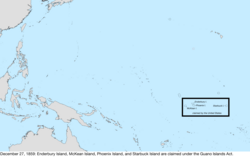 |
| December 29, 1859 | Christmas Island and Malden Island were claimed under the Guano Islands Act.[4] | Pacific Ocean: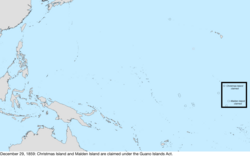 |
| February 8, 1860 | Texas created Greer County, claiming part of Indian Territory based on a different understanding from the federal government of which fork of the Red River was the border between the two.[226] Atafu, Birnie Island, Butaritari, Caroline Island, Fanning Island, Flint Island, Gardner Island, Canton Island, Kingman Reef, Manihiki, Marakei, Nukunono, Palmyra Atoll, Penrhyn, Pukapuka, Rakahanga, Swains Island, Sydney Island, Vostok Island, and Washington Island were all claimed under the Guano Islands Act.[4] Many additional islands were listed as bonded on this date, but based on the coordinates they were either phantoms or duplicates. In addition, Sarah Ann Island was claimed, which may have existed and would be sighted as late as 1917, but has since disappeared.[227] | 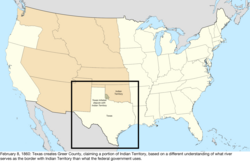 Pacific Ocean:  |
1860–1865 (Civil War)
| Date | Event | Change Map |
|---|---|---|
| December 20, 1860 | In response to the election of Abraham Lincoln, South Carolina proclaimed its secession from the Union, withdrawing from the Congress of the United States.[228] |  Disputes: 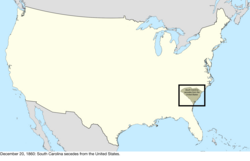 |
| January 9, 1861 | Mississippi proclaimed its secession from the Union, withdrawing from Congress.[228] |  Disputes:  |
| January 10, 1861 | Florida proclaimed its secession from the Union, withdrawing from Congress.[228] |  Disputes:  |
| January 11, 1861 | Alabama proclaimed its secession from the Union, withdrawing from Congress.[228] | 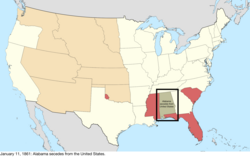 Disputes:  |
| January 19, 1861 | Georgia proclaimed its secession from the Union, withdrawing from Congress.[228] |  Disputes:  |
| January 26, 1861 | Louisiana proclaimed its secession from the Union, withdrawing from Congress.[228] However, the 1st and 2nd congressional districts, around New Orleans, maintained representation in Congress. |  Disputes:  |
| January 29, 1861 | The bulk of Kansas Territory east of 25° west from Washington was admitted as the thirty-fourth state, Kansas. The remainder became unorganized territory.[210][229] |  |
| February 8, 1861 | The Confederate States of America was formed by representatives of the seceded states of Alabama, Georgia, Florida, Louisiana, Mississippi, and South Carolina.[230] | Disputes: |
| February 28, 1861 | Colorado Territory was organized from portions of Nebraska Territory, New Mexico Territory, and Utah Territory, along with unorganized territory.[ak][232][231] |  |
| March 2, 1861 | Texas proclaimed its secession from the Union and was admitted to the Confederate States,[228][233] withdrawing from Congress. Dakota Territory was organized from Nebraska Territory and the unorganized territory north of it.[al] Nebraska Territory's western border was moved to 33° west from Washington, gaining small portions of Utah Territory and Washington Territory.[211][234][235] Nevada Territory was organized from Utah Territory west of 39° west from Washington.[236][237] |  Disputes:  |
| March 28, 1861 | Representatives in the southern half of New Mexico Territory proclaimed an independent Arizona Territory south of 34° north.[238] | Disputes: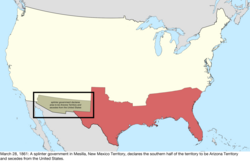 |
| April 12, 1861 | The Battle of Fort Sumter in South Carolina begins the American Civil War. | Disputes: |
| April 17, 1861 | Following the Battle of Fort Sumter and President Abraham Lincoln's call for troops to respond, Virginia proclaimed its secession from the Union, withdrawing from Congress.[228] However, the 1st (along the Eastern Shore), 7th (near Washington, D.C.), and 10th, 11th, and 12th (in the northwest of the state) congressional districts maintained representation in Congress. |  Disputes:  |
| May 6, 1861 | Arkansas proclaimed its secession from the Union, withdrawing from Congress.[228] |  Disputes:  |
| May 7, 1861 | Virginia was admitted to the Confederate States.[239] | Disputes: |
| May 16, 1861 | Kentucky declared itself neutral in the American Civil War. | no change to map |
| May 20, 1861 | Arkansas was admitted to the Confederate States.[240] North Carolina proclaimed its secession from the Union, withdrawing from Congress.[228] |  Disputes: 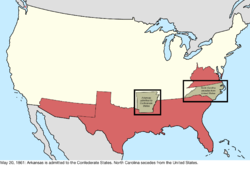 |
| May 21, 1861 | North Carolina was admitted to the Confederate States. The law admitting the state required a presidential proclamation before it was to take effect,[241] which sources say took place on this date;[242] the only primary source found so far is a statement from Jefferson Davis on July 20 stating that the proclamation had been made.[243] | Disputes: |
| June 6, 1861 | Robert Williamson Steele, governor of Jefferson Territory, declared the territory disbanded and handed over the government to the first governor of Colorado Territory.[225] | Unofficial change: |
| June 8, 1861 | Tennessee proclaimed its secession from the Union, withdrawing from Congress.[228] However, the 2nd, 3rd, and 4th congressional districts in the central part of the state maintained representation in Congress. | 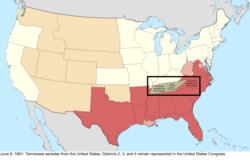 Disputes: 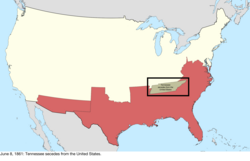 |
| June 25, 1861 | The federal government recognized the Restored Government of Virginia in Wheeling as the legitimate government of Virginia.[244] |  |
| July 2, 1861 | Tennessee was admitted to the Confederate States.[245] | Disputes: |
| August 1, 1861 | Following Confederate victory in the First Battle of Mesilla, Arizona Territory was proclaimed as part of the Confederate States.[246] | Disputes: |
| September 13, 1861 | Following the Confederate occupation of Columbus, Kentucky, on September 3, 1861, the state abandoned neutrality and aligned with the Union government.[247] | no change to map |
| October 31, 1861 | A splinter government in Neosho, Missouri, proclaimed the secession of the state from the United States.[228] | Disputes: |
| November 20, 1861 | A convention in Russellville, Kentucky, proclaimed the formation of a splinter government in Bowling Green and the secession of Kentucky from the United States.[228] | Disputes: |
| November 28, 1861 | The splinter Neosho government of Missouri was admitted to the Confederate States. The Confederate States never held much power over the state, but it was given full representation in the legislature.[248] | Disputes: |
| December 10, 1861 | The splinter Bowling Green government of Kentucky was admitted to the Confederate States. The Confederate States never held much power over the state, but it was given full representation in the legislature.[249] | Disputes: |
| December 21, 1861 | The Confederate States ratified treaties with the Osage, and the Seneca and Shawnee.[250][251] | Disputes: |
| December 23, 1861 | The Confederate States ratified treaties with the Cherokee, granting them a delegate to the Congress of the Confederate States, and with the Seminole, granting them a delegate to be shared with the Creek.[250][251] | Disputes: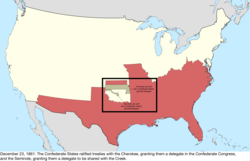 |
| December 31, 1861 | The Confederate States ratified treaties with the Choctaw and Chickasaw, granting them a delegate in the Congress of the Confederate States; with the Comanche; with the Creek, granting them a delegate to be shared with the Seminole; and the Quapaw.[250][251] | Disputes: |
| March 1, 1862 | A decree by the Supreme Court of the United States took effect, modifying the border between Massachusetts and Rhode Island.[am][14][252] |  |
| April 15, 1862 | Palmyra Atoll was annexed by Hawaii, and the American claim falls dormant.[253] | Pacific Ocean: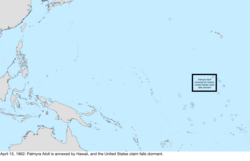 |
| July 14, 1862 | The slice of Utah Territory west of 38° west from Washington was transferred to Nevada Territory.[237][254] | 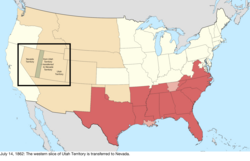 |
| December 30, 1862 | The Swan Islands were claimed under the Guano Islands Act.[4] | Caribbean Sea: |
| February 24, 1863 | Arizona Territory was organized from the half of New Mexico Territory west of 32° west from Washington.[255][256] |  |
| March 3, 1863 | Idaho Territory was organized from the parts of Dakota Territory and Nebraska Territory west of 27° west from Washington, and the half of Washington Territory east of the Snake River and a line north from the mouth of the Clearwater River.[257][258] |  |
| March 4, 1863 | Due to disruption in voting and low turnout, no one was allowed to take the seats in the United States House of Representatives held by the Unionist areas of Louisiana, Tennessee, and Virginia, effectively expelling the states.[259] | 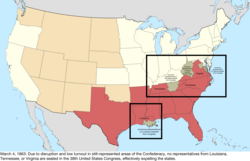 |
| June 20, 1863 | The northwestern counties of Virginia, represented by the Restored Government of Virginia in Wheeling, were split from the rest of Virginia and admitted to the Union as the thirty-fifth state, West Virginia.[an][261][260] The Restored Government of Virginia was relocated to Alexandria. |  |
| August 5, 1863 | Berkeley County was transferred by the federal government from Virginia to West Virginia.[262] |  |
| November 2, 1863 | Jefferson County was transferred from Virginia to West Virginia.[263] | 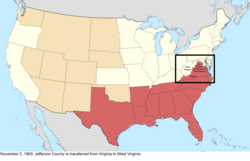 |
| May 26, 1864 | Montana Territory was organized from the northeast third of Idaho Territory,[ao] and the southeast third of Idaho Territory was transferred to Dakota Territory.[ap][264][235][265] |  |
| October 15, 1864 | Malden Island was claimed by the United Kingdom.[266] | Pacific Ocean: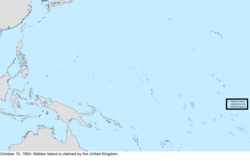 |
| October 31, 1864 | Nevada Territory was admitted as the thirty-sixth state, Nevada.[237][267] | 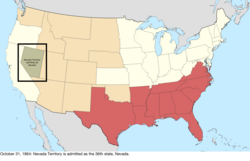 |
| May 5, 1865 | The Confederate States cabinet met in Washington, Georgia, and dissolved.[268] Military surrenders were scattered throughout 1865, but the most important is regarded as that of the Army of Northern Virginia following the Battle of Appomattox Court House on April 9. | Disputes: |
1866–1897 (Reconstruction and western statehood)
| Date | Event | Change Map |
|---|---|---|
| May 5, 1866 | The slice of Utah Territory west of 37° west from Washington was transferred to Nevada.[269] |  |
| July 24, 1866 | Tennessee was readmitted to Congress.[270] | 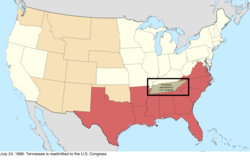 |
| December 26, 1866 | Starbuck Island was claimed by the United Kingdom.[266] | Pacific Ocean: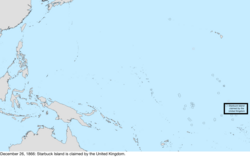 |
| January 18, 1867 | The northwestern corner of Arizona Territory, west of the Colorado River and 37° west from Washington, was transferred to Nevada. The law transferring the land was approved May 5, 1866, but unlike the Utah Territory transfer of that day, this transfer was contingent on the state accepting it.[269][271] |  |
| March 1, 1867 | Nebraska Territory was admitted as the thirty-seventh state, Nebraska.[211][272] | 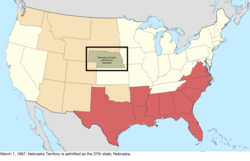 |
| July 1, 1867 | Canada was formed from several British colonies, including New Brunswick, thus inheriting the dispute over Machias Seal Island and North Rock. | Disputes: |
| August 28, 1867 | Midway Atoll was claimed.[273] An attempt had been made at the time of its discovery in 1859 to claim it under the Guano Islands Act.[274] | Pacific Ocean: |
| October 18, 1867 | Alaska was purchased from the Russian Empire and designated the Department of Alaska.[aq][276][277] Due to a vague description and lack of quality surveying, the southeastern border with British holdings was unclear and disputed.[275] | Northwestern North America: |
| June 22, 1868 | Arkansas was readmitted to Congress.[278] | 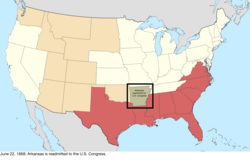 |
| June 25, 1868 | Florida was readmitted to Congress.[279] |  |
| July 4, 1868 | North Carolina was readmitted to Congress.[280] |  |
| July 9, 1868 | Louisiana and South Carolina were readmitted to Congress.[281] Caroline Island was claimed by the United Kingdom.[266] | 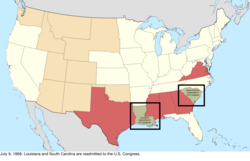 Pacific Ocean:  |
| July 13, 1868 | Alabama was readmitted to Congress.[282] | 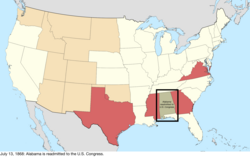 |
| July 25, 1868 | Georgia was readmitted to Congress.[283] Wyoming Territory was organized from portions of Dakota, Idaho, and Utah Territories.[ar][285][284] The territory would remain under the jurisdiction of the Dakota Territory until its own government was organized on May 19, 1869.[286] The act organizing Wyoming Territory became law on this date, but it is unclear if the territory could be considered "organized" until May 19, 1869, as the act specifies it was not to take effect until a government is organized; however, all sources use this date as the creation, and most use it for the organization, of the territory. A tiny portion of the Dakota Territory was erroneously left behind on the western side of Wyoming Territory.[287] |  |
| August 12, 1868 | The list of bonded guano island claims mentions "Islands in Caribbean Sea not named" bonded on this date, but it is unknown to what this is referring.[4] | no change to map |
| December 11, 1868 | Serrana Bank was claimed under the Guano Islands Act.[4] Colombia has claimed it throughout its history. | Caribbean Sea: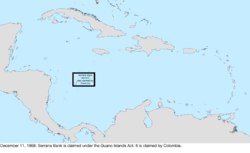 |
| March 3, 1869 | Georgia was again expelled from Congress following failures of Reconstruction in the state.[288] | 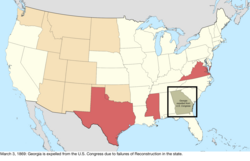 |
| November 22, 1869 | Bajo Nuevo Bank, Pedro Cays, Quita Sueño Bank, and Roncador Bank were claimed under the Guano Islands Act.[4][273] Except for Pedro Cays, Colombia has claimed them throughout its history. | Caribbean Sea: |
| January 26, 1870 | Virginia was readmitted to Congress.[289] | 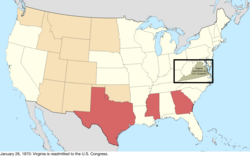 |
| February 23, 1870 | Mississippi was readmitted to Congress.[290] | 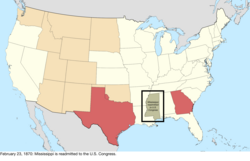 |
| March 30, 1870 | Texas was readmitted to Congress.[291] |  |
| July 15, 1870 | Georgia was again readmitted to Congress.[292] The North-Western Territory was transferred by the United Kingdom to Canada, thus transferring its portion of the Alaska boundary dispute.[293] |  Northwestern North America:  |
| February 9, 1871 | A small parcel was transferred from Dakota Territory to Nebraska following a sudden change in course of the Missouri River.[211][294] |  |
| July 20, 1871 | British Columbia joined Canada, transferring the dispute over the San Juan Islands as well as its portion of the Alaska boundary dispute.[295] | Disputes: Northwestern North America:  |
| October 21, 1872 | The dispute with Canada over the San Juan Islands was resolved in the favor of the United States claim.[178] | Disputes: |
| 1873 | Vostok Island was claimed by the United Kingdom.[296] | Pacific Ocean: |
| February 17, 1873 | The small portion of Dakota Territory that was left behind when Wyoming Territory was created was transferred to Montana Territory.[287][297] |  |
| August 1, 1876 | Colorado Territory was admitted as the thirty-eighth state, Colorado.[231][298] |  |
| August 13, 1877 | The United Kingdom created the British Western Pacific Territories, including Atafu and Nukunono.[299] | Pacific Ocean: |
| March 3, 1879 | The border across the Chesapeake Bay between Maryland and Virginia was decided via arbitration. It is unknown if any land actually changed hands.[13] | too vague to map |
| September 8, 1879 | Arenas Key, claimed by Mexico; the Morant Cays; and Serranilla Bank, claimed by Colombia, were claimed by the United States under the Guano Islands Act;[4] according to the Office of Insular Affairs, Serranilla Bank was claimed again on September 13, 1880.[273] | Caribbean Sea: |
| April 7, 1880 | A very small area of Fair Haven, Vermont, was transferred to New York due to a change in the course in the Poultney River.[32][300] | too small to map |
| September 13, 1880 | Western Triangle Island, claimed by Mexico, was claimed by the United States under the Guano Islands Act.[4] The list of bonded claims also mentions a "De Anes" island claimed on this date, with coordinates matching Isla de Aves; however, the same list points out that the claim to "Aves Island" was found to be invalid. | Caribbean Sea: |
| 1881 | Flint Island was claimed by the United Kingdom.[301] | Pacific Ocean: |
| May 23, 1882 | The area between 43° north and the Keya Paha and Niobrara Rivers was transferred from Dakota Territory to Nebraska.[235][302] The act was passed in Congress on March 28 and accepted by the Nebraska legislature on this date.[303] |  |
| June 1, 1882 | The Morant Cays and Pedro Cays were annexed by the United Kingdom to Jamaica; it appears they were no longer claimed by the United States after this.[304] | Caribbean Sea: |
| May 17, 1884 | The Department of Alaska was organized into the District of Alaska.[305] | Northwestern North America: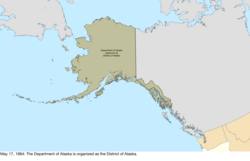 |
| June 21, 1884 | The Alacrans Islands, claimed by Mexico, were claimed under the Guano Islands Act.[4] | Caribbean Sea: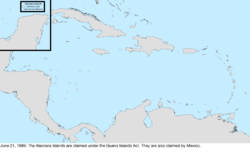 |
| March 15, 1888 | Fanning Island was annexed by the United Kingdom; it appears the island was no longer claimed by the United States after this.[306] | Pacific Ocean: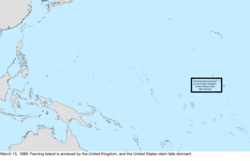 |
| March 17, 1888 | Christmas Island was claimed by the United Kingdom.[266] | Pacific Ocean: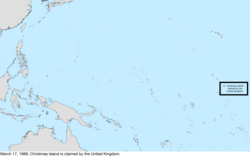 |
| October 26, 1888 | The Cook Islands became a protectorate of the United Kingdom, thus initiating a claim on the atolls of Manihiki, Penrhyn, Pukapuka, and Rakahanga.[266] | Pacific Ocean: |
| May 29, 1889 | Washington Island was annexed by the United Kingdom; it appears the island was no longer claimed by the United States after this.[306] | Pacific Ocean: |
| June 3, 1889 | Jarvis Island was claimed by the United Kingdom.[266] | Pacific Ocean: |
| June 26, 1889 | Sydney Island was claimed by the United Kingdom.[266] | Pacific Ocean: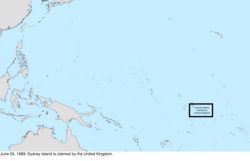 |
| June 29, 1889 | Phoenix Island was claimed by the United Kingdom.[266] | Pacific Ocean: |
| July 10, 1889 | Birnie Island was claimed by the United Kingdom.[266] | Pacific Ocean: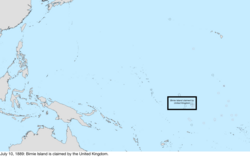 |
| November 2, 1889 | Dakota Territory was split in half along the "seventh standard parallel north", a few miles south of 46° north, and admitted as the thirty-ninth state, North Dakota, and the fortieth state, South Dakota.[235][307] |  |
| November 8, 1889 | Montana Territory was admitted as the forty-first state, Montana.[264][307] |  |
| November 11, 1889 | Washington Territory was admitted as the forty-second state, Washington.[208][307] | 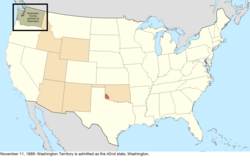 |
| May 2, 1890 | Oklahoma Territory was organized from the Public Land Strip and the western half of Indian Territory, except for the Cherokee Outlet, which would be added later upon cession from the Cherokee.[as][309][308] |  |
| July 3, 1890 | Idaho Territory was admitted as the forty-third state, Idaho.[258][310] |  |
| July 10, 1890 | Wyoming Territory was admitted as the forty-fourth state, Wyoming.[284][311] | 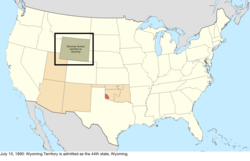 |
| March 8, 1892 | The Gilbert Islands became a protectorate of the United Kingdom, thus initiating a claim on Butaritari and Marakei.[266] No record of a United States claim exists after this point, so it is assumed this is when the claim fell dormant. | Pacific Ocean: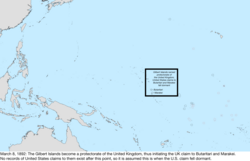 |
| May 28, 1892 | Gardner Island was claimed by the United Kingdom.[266] | Pacific Ocean: |
| September 16, 1893 | Per a treaty with the Cherokee, the federal government purchased the Cherokee Outlet in the Indian Territory and opened it to settlement, transferring it to Oklahoma Territory as provided in the Oklahoma Organic Act.[308][312] |  |
| November 17, 1894 | The Alacrans Islands, Arenas Key, and Western Triangle Island were stricken from the list of claimed guano islands.[4] | Caribbean Sea: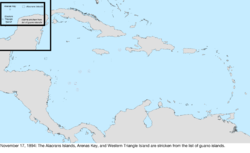 |
| January 4, 1896 | Utah Territory was admitted as the forty-fifth state, Utah.[201][313] |  |
| March 16, 1896 | The dispute between the federal government, on behalf of Oklahoma Territory, and Texas over Greer County was resolved in favor of the federal claim.[226] | 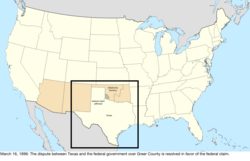 |
| July 24, 1897 | Due to an earlier shift in the course of the Missouri River, an island was transferred from Nebraska to South Dakota.[314] |  |
1898–1945 (Pacific and Caribbean expansion)
| Date | Event | Change Map |
|---|---|---|
| August 12, 1898 | The Republic of Hawaii was annexed.[315] The ceremony to transfer sovereignty occurred on this date; the act was signed on July 7, 1898.[316] Johnston Atoll was not included with Hawaii, nor was Sikaiana Atoll, which had been ceded to Hawaii in 1856 by its residents and approved by King Kamehameha IV. However, the annexation was based on the islands named in a report of the Hawaiian Commission, which omitted Sikaiana.[317][318] | Pacific Ocean: |
| January 17, 1899 | Wake Island was claimed.[319] | Pacific Ocean: |
| April 11, 1899 | Guam, Porto Rico, and, on agreed payment of $20 million, the Philippines were ceded by Spain following the Spanish–American War.[320] The Philippines were claimed by the First Philippine Republic. The ceded region for the Philippines included the island of Palmas, which was administered by the Netherlands. This overlap would not be noticed until January 21, 1906.[321] While the United States occupied Cuba for a time, it was not ceded nor claimed. | Pacific Ocean: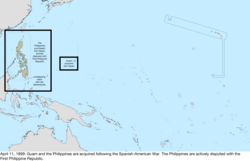 Caribbean Sea: 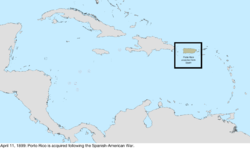 |
| February 16, 1900 | The United States took ownership of the Samoan Islands east of 171° west, per the terms of the Tripartite Convention.[322] | Pacific Ocean: |
| February 19, 1900 | The newly acquired Samoan islands were established as Naval Station, Tutuila. It included all of the islands granted by the Tripartite Convention, though formal cession of the islands by local authorities would take place later in 1900 and 1904.[322] | Pacific Ocean: |
| April 12, 1900 | Porto Rico was organized into a civil territory.[323] | no change to map |
| April 17, 1900 | The island of Tutuila was formally ceded to the United States and added to Naval Station, Tutuila.[322][324] As the United States had already claimed the island on February 19, 1900, no change is mapped. The treaty would be ratified by Congress on February 20, 1929. | no change to map |
| June 14, 1900 | The former Republic of Hawaii was organized into Hawaii Territory.[325][326] | Pacific Ocean: |
| March 3, 1901 | The transfer for a thin sliver of Bristol, Tennessee, to Bristol, Virginia, was approved by Congress after having been approved by both states.[327][328] The location of the border along Main Street (now State Street) between the two cities was either the northern sidewalk of the street, or down the middle of the street; Tennessee's cession of the northern half of the street laid the issue to rest. | too small to map |
| March 23, 1901 | The president of the First Philippine Republic, Emilio Aguinaldo, was captured, and the republic was dissolved. On this same date several islands, Cagayan de Sulu and Sibutu among them, were purchased from Spain and assigned to the Philippines, which was then being governed as a U.S. insular area. The borders specified in the Treaty of Paris of 1898 had excluded these islands; the new treaty simply ceded "any and all islands belonging to the Philippine Archipelago".[329][330] | Pacific Ocean: |
| July 4, 1901 | The Insular Government of the Philippine Islands was established.[331][332] | Pacific Ocean: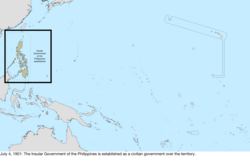 |
| July 1, 1902 | The Philippines were organized.[333] | no change to map |
| October 20, 1903 | The Alaska boundary dispute with Canada was resolved, generally in favor of the United States claim.[275] | Northwestern North America: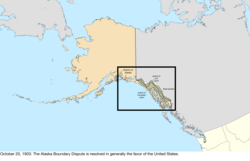 |
| December 10, 1903 | Land along southern Guantánamo Bay was leased in perpetuity from Cuba for use as a naval base;[334] the treaty took effect February 23, 1903, and the formal handover occurred on this date.[335] | no change to map |
| May 4, 1904 | The United States took ownership of the Panama Canal Zone. At this stage, only the most basic borders were defined; it was a zone surrounding the canal on each side for five miles, but excluded the cities of Colón and Panama City, which remained exclaves of Panama, as well as the water for their harbors.[336] The Hay–Bunau-Varilla Treaty granting it to the United States was ratified on February 26, 1904.[337] A formal border agreement, which also gave the Canal Zone some land and a lighthouse in northwest Colón, would be ratified on June 15, 1904.[338][339] | Caribbean Sea: |
| July 16, 1904 | The Manuʻa islands were formally ceded to the United States and added to Naval Station, Tutuila.[322] As the United States had already claimed the islands on February 19, 1900, no change is mapped. The treaty would be ratified by Congress on February 20, 1929. | no change to map |
| December 12, 1904 | The "Taft Agreement" was made with Panama on December 3, with one of its sections refining the maritime boundary of the harbor of Panama City and the Panama Canal Zone.[340][341] It became effective December 12. | no change to map |
| February 10, 1905 | The border between Arkansas and Indian Territory was slightly adjusted near Fort Smith, Arkansas, transferring a small amount of land on the east side of the Poteau River to Arkansas.[342][343] | 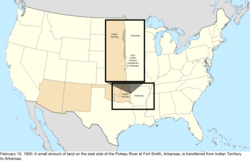 |
| September 26, 1907 | New Zealand became largely independent from the United Kingdom,[344] inheriting the claim on the atolls of Manihiki, Penrhyn, Pukapuka, and Rakahanga. | Pacific Ocean: |
| November 16, 1907 | Indian Territory and Oklahoma Territory were combined and admitted as the forty-sixth state, Oklahoma.[308][345] |  |
| April 11, 1908 | A boundary treaty with the United Kingdom on behalf of Canada redefined the maritime borders between the United States and Canada.[346] Among other changes, this "de-enclaved" Horseshoe Reef Lighthouse in Lake Erie by making the water around it contiguous with the water on the American side of the border.[203][347] | no change to map |
| January 1, 1909 | The new Constitution of Michigan included some area of Wisconsin within its definition of Michigan.[348] |  |
| August 20, 1910 | A boundary treaty with the United Kingdom on behalf of Canada addressed a slight uncertainty in the maritime border in Passamaquoddy Bay between Maine and Canada.[349][350][351] The border was adjusted to run east of Pope's Folly Island, which previously lay on the border line, and had been the subject of some debate for many years.[352][353] |  |
| July 17, 1911 | Naval Station, Tutuila, was renamed American Samoa;[354] the station continued to operate separate from territorial governance until 1951. | Pacific Ocean: |
| January 6, 1912 | New Mexico Territory was admitted as the forty-seventh state, New Mexico.[204][355] | 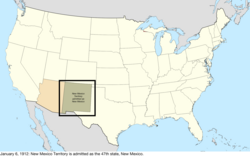 |
| February 14, 1912 | Arizona Territory was admitted as the forty-eighth state, Arizona.[255][356] | 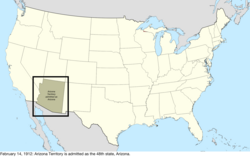 |
| August 24, 1912 | The District of Alaska was reorganized as the Alaska Territory.[357] | Northwestern North America: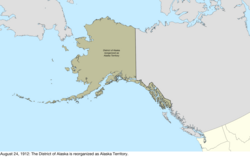 |
| January 31, 1913 | New Mexico filed suit in the Supreme Court against Texas over the "Country Club Dispute", questioning whether the present course or the 1850 course of the Rio Grande should be their border.[358] |  |
| August 5, 1914 | The Corn Islands were leased from Nicaragua for a period of 99 years; however, this was not a full transfer of sovereignty, and the islands were never administered as an insular area.[359] | no change to map |
| May 1, 1915 | The borders of the Panama Canal Zone were explicitly defined. Whereas the original definition was a simple corridor surrounding the canal, this treaty specified the actual border. Among the changes this caused were: a slice of Canal Zone was ceded to Panama so Panama City would be connected with the rest of the country; the middle island of the Las Tres Hermanas Islands, which marked the border of Panama City's harbor, was wholly made part of Canal Zone; Gatun Lake and other surrounding waters were formally annexed to the territory; and an area of northwest Colón was ceded to Canal Zone.[360][361][362] | Caribbean Sea: |
| May 27, 1915 | Under Article II of the 1903 Treaty, the United States expropriated from Panama several areas around the mouth of the Rio Chagres, annexing them to the Panama Canal Zone.[363] | too small to map |
| December 8, 1915 | The United States expropriated from Panama a triangle of land, which included the historic Fort San Lorenzo, between the Rio Chagres, Caribbean Sea and the Panama Canal Zone, to which it was annexed.[363] | too small to map |
| January 17, 1916 | Navassa Island was formally claimed for lighthouse purposes.[364] | no change to map |
| August 29, 1916 | The Philippines were reorganized to provide more autonomous government.[365] | no change to map |
| March 31, 1917 | The Danish Virgin Islands were purchased from Denmark[366] and renamed the United States Virgin Islands.[367] | Caribbean Sea: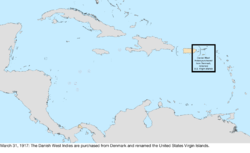 |
| July 12, 1918 | The United States expropriated from Panama 2.6 hectares of land at Punta Paitilla in Panama City and annexed it to the Panama Canal Zone.[368] That area was enlarged to about 50 hectares within several months.[363][369][370][371] | too small to map |
| August 21, 1918 | The United States expropriated from Panama land between the Rio Chagres and the Quebrada Majagual and annexed it to the Panama Canal Zone.[363][371] | Caribbean Sea: |
| September 13, 1918 | Minnesota and Wisconsin exchanged islands in the Mississippi River: Island Seventytwo was transferred to Winona, Minnesota, and Barron's Island was transferred to La Crosse, Wisconsin.[158][372] |  |
| September 18, 1919 | The island of Largo Remo was annexed to the Panama Canal Zone under the United States right of expropriation in the 1903 Canal Treaty.[373] | Caribbean Sea: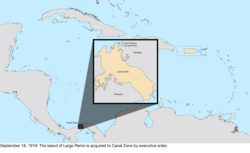 |
| June 16, 1920 | Fifteen hectares on the island of Taboga Island were annexed to the Panama Canal Zone.[374] | too small to map |
| June 30, 1921 | The "Wedge" dispute between Delaware and Pennsylvania was resolved in Delaware's favor. The disputed land had generally been administered by Delaware, even electing a member of the Delaware legislature in the mid-19th century,[375] but federal maps had included the land as part of Pennsylvania at least as late as 1900.[376] The states had agreed on a resolution, and it was affirmed by an act of Congress on this date.[377][378] Some sources, both contemporary and modern, note that, in the original process of resurveying the border in 1892, a very thin, horn-shaped region along the arc was transferred from Delaware to Pennsylvania;[375][378][379] however, no federal maps found reflect this, and it is unclear if this transfer actually occurred. |  |
| May 10, 1922 | Kingman Reef was formally annexed.[380] | no change to map |
| October 8, 1923 | Michigan expanded its claim to Wisconsin territory, though Wisconsin never lost control over the area.[348] |  |
| November 15, 1923 | The Swan Islands were claimed by Honduras.[381] | Caribbean Sea: |
| February 1, 1924 | The future area for Madden Lake was annexed to the Panama Canal Zone under the United States right of expropriation in the 1903 Canal Treaty.[339][382][383] | Caribbean Sea: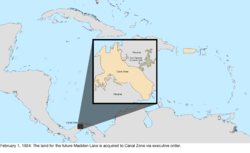 |
| March 4, 1925 | Swains Island was added to American Samoa.[384] | Pacific Ocean: |
| July 17, 1925 | The border with Canada was adjusted in several places.[385][386] The only change to a land border redefined how the border between the Lake of the Woods and the Rocky Mountains should be considered; previously, the border followed the curve of the parallel between each border monument, while the treaty changed this to straight lines between each monument. Through this, the United States netted a gain of between 30 and 35 acres of land. Due to the extremely small shift, the lack of specific documentation of where the changes occurred, and the lack of any human impact, this change is not mapped. There was also a change to the border in the Lake of the Woods; due to a surveying anomaly, the previous border intersected itself several times in the lake, creating enclaves of United States water surrounded by Canadian water. The treaty changed the border to use the southernmost intersection as the northwestern point of the Lake of the Woods. Finally, the maritime border in the Bay of Fundy was adjusted, netting Canada roughly 9 acres of water. | too small to map |
| March 1, 1926 | The Supreme Court of the United States resolved the conflict between Michigan and Wisconsin in the favor of Wisconsin.[348] | 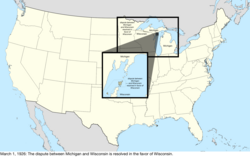 |
| July 29, 1926 | Johnston Atoll was established as a federal bird refuge and placed under the jurisdiction of the United States Department of Agriculture.[387] The atoll had originally been claimed by both the United States and Hawaii in 1858, but little activity apart from guano mining had taken place, and it had been largely abandoned for decades.[224] | no change to map |
| November 22, 1926 | The Supreme Court of the United States defined the border between Michigan and Wisconsin, transferring all islands south of the Quinnesec Falls on the Menominee River to Wisconsin, and all islands north of the falls to Michigan; it is unknown specifically which islands were transferred in this fashion. However, an error in the border description introduced a small overlap between the two states over several islands in Lake Michigan north of the Door Peninsula.[388] |  |
| July 18, 1927 | The United States expropriated from Panama another 33 hectares of land on the islands of Taboga and Taboguilla and annexed them to the Panama Canal Zone.[363] | too small to map |
| October 26, 1927 | Two bancos along the Colorado River were ceded from Mexico to Arizona.[389][390] | too small to map |
| December 5, 1927 | The "Country Club Dispute" between New Mexico and Texas was resolved in Texas's favor.[391] |  |
| April 4, 1928 | The Island of Palmas Case was decided in the favor of the Netherlands, ceding Palmas to the Dutch East Indies.[321] | Pacific Ocean: |
| September 24, 1928 | The United States expropriated from Panama three hectares of land at El Cerro de Doscientos Pies ("200-Foot Hill") near Las Minas Bay and annexed it to the Panama Canal Zone.[363][371] | too small to map |
| July 22, 1930 | The United States expropriated from Panama 25 hectares on Jicarita Island and 60 hectares at Punta Morro de Puercos and annexed them to the Panama Canal Zone.[363] | too small to map |
| April 15, 1931 | The United States expropriated from Panama additional areas around the soon-to-be-built Madden Dam and annexed them to the Panama Canal Zone.[363][371] | Caribbean Sea: |
| May 3, 1932 | The United States adjusted the border at Punta Paitilla in the Canal Zone, returning a small amount of land to Panama. This was the site for a planned new American embassy, which had to be built on foreign soil.[392] | too small to map |
| May 17, 1932 | Porto Rico was renamed Puerto Rico.[393] | Caribbean Sea: |
| December 13, 1932 | The Mangsee Islands and seven of the Turtle Islands were ceded by the United Kingdom from North Borneo to the Philippines. The islands were supposed to be included in the 1900 transfer of islands from Spain to the United States. Per the terms of the treaty, the United Kingdom continued to administer the islands until requested, and, after the Philippines' independence, the Philippine government made such a request and took control.[394] | Pacific Ocean: |
| May 29, 1933 | The Supreme Court of the United States ruled that the border between New Hampshire and Vermont was the low water mark of the west bank of the Connecticut River; Vermont had sought to have the border placed in the middle of the river.[44] | no change to map |
| November 13, 1933 | A treaty created the Rio Grande Rectification Project, which, from 1935 to 1938, straightened and stabilized the path of the Rio Grande through the El Paso–Juárez Valley. By the end of the project, 174 parcels had been transferred between Mexico and Texas, each side receiving an equal area of land.[395][396] | too small to map |
| December 29, 1934 | Kingman Reef was placed under the jurisdiction of the United States Department of the Navy.[380] | no change to map |
| November 15, 1935 | The Insular Government of the Philippine Islands was dissolved and replaced with the Commonwealth of the Philippines.[397][398] | Pacific Ocean: |
| March 16, 1936 | The de jure overlap between Michigan and Wisconsin was resolved by the Supreme Court of the United States.[399] |  |
| May 13, 1936 | Baker Island, Howland Island, and Jarvis Island were formally annexed and placed under the jurisdiction of the United States Department of the Interior,[400] ending the United Kingdom's claim to Jarvis Island.[266] | Pacific Ocean: |
| June 22, 1936 | The U.S. Virgin Islands were organized into a civil territory.[401] | no change to map |
| August 6, 1936 | Canton Island, Enderbury Island, and McKean Island were claimed by the United Kingdom.[266] | Pacific Ocean: |
| April 6, 1939 | The condominium of the Canton and Enderbury Islands was established with the United Kingdom.[402] | Pacific Ocean: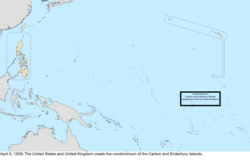 |
| July 27, 1939 | Panama gained a sovereign corridor that was carved out of the Panama Canal Zone connecting Colón with the rest of Panama, along with a three-dimensional "tube" of sovereignty for a future crossing over an American highway. A corridor consisting of the road from the Canal Zone boundary to Madden Dam was annexed to the Canal Zone.[403] | Caribbean Sea: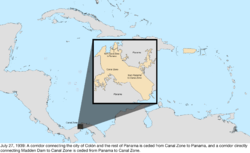 |
| August 16, 1939 | This is the earliest date so far discovered for when the United States began claiming Fakaofo, Funafuti, Hull Island, Niulakita, Nukufetau, and Nukulaelae.[404] | Pacific Ocean: |
| December 10, 1941 | Governor George McMillin surrendered Guam to the Japanese military.[405] | Pacific Ocean: |
| December 23, 1941 | The garrison on Wake Island surrendered to the Japanese military.[406] | Pacific Ocean: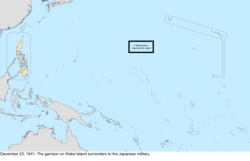 |
| March 26, 1942 | The government of the Philippines evacuated from the territory in the face of Japanese advance. A government-in-exile would be established in Washington, D.C., on May 17, 1942. The United States Army Forces in the Far East would surrender on April 9, 1942, following the Battle of Bataan, and the final military holdouts would surrender on May 6, 1942, following the Battle of Corregidor.[407] | Pacific Ocean: |
| October 14, 1943 | The Second Philippine Republic was established as a puppet state of Japan.[407] | Pacific Ocean: |
| August 10, 1944 | Guam was captured from Japan.[405] | Pacific Ocean: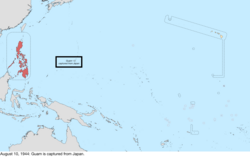 |
| August 17, 1945 | The Second Philippine Republic, in exile in Tokyo since April 3, 1945, was dissolved. The process of re-establishing the Commonwealth government on Philippine soil had started on October 23, 1944.[407] | Pacific Ocean: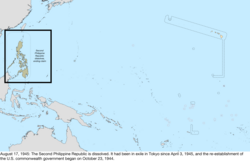 |
| September 4, 1945 | The Japanese garrison on Wake Island surrendered to the United States.[406] | Pacific Ocean: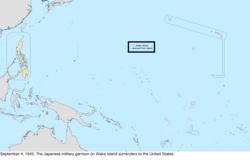 |
1946–present (Decolonization)
| Date | Event | Change map |
|---|---|---|
| July 4, 1946 | The Commonwealth of the Philippines became independent as the Republic of the Philippines.[408] | Pacific Ocean: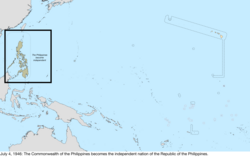 |
| July 18, 1947 | The United Nations entrusted the Trust Territory of the Pacific Islands to the United States.[7] | Pacific Ocean: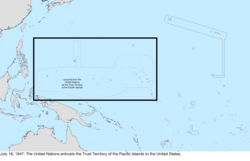 |
| January 1, 1949 | The Tokelau Islands were incorporated into New Zealand, which inherited the claims on Atafu, Fakaofo, and Nukunono.[409] | Pacific Ocean: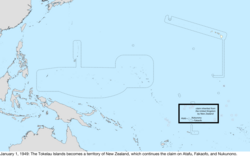 |
| August 1, 1950 | Guam was organized into a civil territory.[410][411] | no change to map |
| August 3, 1950 | Kansas and Missouri exchanged small portions of land along the Missouri River, due to shifts in the river following a flood in 1944.[412] |  |
| April 11, 1955 | Panama's corridor connecting Colón with the rest of Panama was realigned within the Panama Canal Zone. Several three-dimensional "tubes" of sovereignty were also created, allowing Panamanian bridges to pass over rivers and a highway at several locations within the Canal Zone.[413][414] | too small to map |
| August 23, 1955 | Several border locations of the Panama Canal Zone were redefined. Punta Paitilla, the land held on Taboga Island, and the remaining American holdings in Colón and Panama City were ceded to Panama.[339][415] | Caribbean Sea: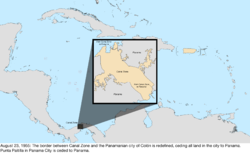 |
| January 3, 1959 | The Alaska Territory was admitted as the forty-ninth state, Alaska.[276] | Northwestern North America: |
| August 21, 1959 | Most of Hawaii Territory was admitted as the fiftieth state, Hawaii. Palmyra Atoll was excluded from statehood and remained a territory.[253][326] | Pacific Ocean: |
| August 25, 1961 | About 20 acres of land was transferred from Minnesota to North Dakota near Fargo, North Dakota.[170][416] | too small to map |
| January 14, 1964 | The Chamizal, a tract of land between El Paso, Texas, and Ciudad Juárez, Chihuahua, was divided between the United States and Mexico.[417] |  |
| August 4, 1965 | The Cook Islands became self-governing from New Zealand. It claimed the atolls of Manihiki, Penrhyn, Pukapuka, and Rakahanga.[418] | Pacific Ocean: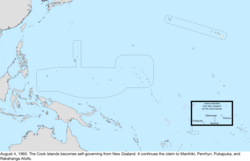 |
| December 30, 1966 | Land on Diego Garcia in the Indian Ocean was leased from the United Kingdom for use as a military base.[419] | no change to map |
| April 25, 1971 | The lease of the Corn Islands from Nicaragua was terminated.[359] | no change to map |
| September 1, 1972 | The United States recognized the sovereignty of Honduras over the Swan Islands.[359][420] | Caribbean Sea: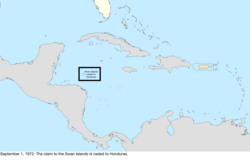 |
| March 1, 1977 | The United States claimed maritime borders west of the Strait of Juan de Fuca, within the Dixon Entrance, and in the Beaufort Sea that conflicted with claims of Canada.[421] | no change to map |
| May 26, 1977 | Several parcels were exchanged between Texas and Mexico along the Rio Grande in areas near Presidio and Hidalgo, Texas,[422] including the Horcón Tract, on which the town of Río Rico was located,[423] and Beaver Island near Roma, Texas. In addition, Mexico ceded 823 acres (3.33 km2) to the U.S., while the U.S. ceded 2,177 acres (8.81 km2) to Mexico, primarily to straighten sections of the Rio Grande for flood control.[424] |  |
| December 16, 1977 | A treaty defining the maritime border with Cuba was signed; though it has never been ratified by the United States Senate, it is provisionally enforced by agreement renewed every two years.[351] | no change to map |
| October 1, 1978 | Tuvalu became independent from the United Kingdom. It claimed the atolls of Funafuti, Nukufetau, Nukulaelae, and Niulakita.[425] | Pacific Ocean: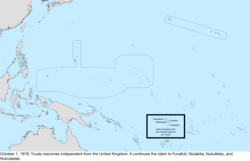 |
| July 12, 1979 | The Republic of Kiribati became independent from the United Kingdom. It claimed Birnie Island, Canton Island, Caroline Island, Christmas Island, Enderbury Island, Flint Island, Gardner Island, Hull Island, Malden Island, McKean Island, Phoenix Island, Starbuck Island, Sydney Island, and Vostok Island. This dissolved the condominium of the Canton and Enderbury Islands.[426] | Pacific Ocean: |
| October 1, 1979 | The Panama Canal Zone was ceded to Panama. The United States and Panama continued to share operational control of the canal until December 31, 1999, when it would be fully turned over to Panama.[427] The United States retained control over several hundred specified areas to be turned over in piecemeal fashion over the years. | Caribbean Sea: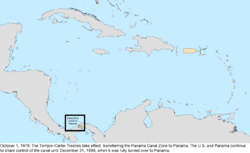 |
| November 24, 1980 | The maritime border between the United States and Venezuela was defined.[351][428] | no change to map |
| September 17, 1981 | The United States recognized the sovereignty of Colombia over Roncador Bank and Serrana Bank, and the claim on Quita Sueño Bank was abandoned by the United States, as it was no longer above the seas at high tide, and thus the government considered it unclaimable.[359][429] | Caribbean Sea: |
| September 3, 1983 | The United States recognized the sovereignty of the New Zealand territory of Tokelau over Atafu, Fakaofo, and Nukunono, and defined the maritime border with Tokelau.[351][359][430] | Pacific Ocean: |
| September 8, 1983 | The United States recognized the sovereignty of the Cook Islands over Manihiki, Penrhyn, Pukapuka, and Rakahanga, and the maritime border with the Cook Islands was defined.[351][359][431] | Pacific Ocean: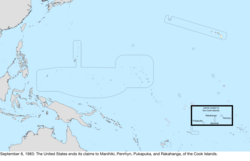 |
| September 23, 1983 | The United States recognized the sovereignty of Kiribati over Birnie Island, Canton Island, Caroline Island, Christmas Island, Enderbury Island, Flint Island, Gardner Island, Hull Island, Malden Island, McKean Island, Phoenix Island, Starbuck Island, Sydney Island, and Vostok Island.[359][432] The United States recognized the sovereignty of Tuvalu over Funafuti, Nukufetau, Nukulaelae, and Niulakita.[359][433] | Pacific Ocean: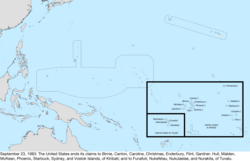 |
| October 12, 1984 | The International Court of Justice made its judgment on where the maritime border should be in the Gulf of Maine between the United States and Canada.[434][351] No land changed hands. The scope of the case did not include the sovereignty of Machias Seal Island, but the judgment enabled defining the extent of the disputed water area around that island (an area of 210 square nautical miles).[421] | no change to map |
| October 21, 1986 | The Marshall Islands District of the Trust Territory of the Pacific Islands became independent as the Republic of the Marshall Islands.[435] The Marshall Islanders had claimed Wake Island as part of their territory since at least 1973, and continued that after independence.[436] | Pacific Ocean: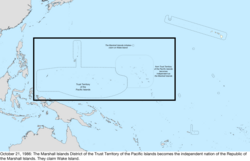 |
| November 3, 1986 | Most of the Trust Territory of the Pacific Islands was dissolved by the United Nations. The districts of Chuuk, Pohnpei, and Yap became independent as the Federated States of Micronesia. The Mariana Islands District, having already been taking moves towards integration with the United States, became a territory of the United States, the Commonwealth of the Northern Mariana Islands.[435] | Pacific Ocean: |
| June 1, 1990 | The maritime border between the United States and the Soviet Union was provisionally defined.[437][351] The two countries agreed on this date to abide by the terms of the treaty pending its ratification and entry into force,[438] but while it was ratified by the United States Senate on September 16, 1991,[439] it was never ratified by the Soviet Union or its successor state, Russia. | no change to map |
| October 1, 1994 | The remaining district of the Trust Territory of the Pacific Islands, the Palau District, became independent as the Republic of Palau, dissolving the TTPI.[440] | Pacific Ocean: |
| June 1, 1995 | The maritime border between the United States and territories of the United Kingdom in the Caribbean Sea was defined.[351][441][442] | no change to map |
| January 16, 1997 | Navassa Island was transferred to the United States Department of the Interior.[443][444] | no change to map |
| November 13, 1997 | The maritime border between the United States and Mexico was defined.[351][445] | no change to map |
| May 26, 1998 | The Supreme Court ruled that extra land added to Ellis Island since the original island was officially granted to New York in an interstate compact with New Jersey in 1834 belonged to New Jersey, owing to the fact that the island was within the territorial waters of New Jersey. The original natural boundary of Ellis Island remained an enclave of New York.[446] | 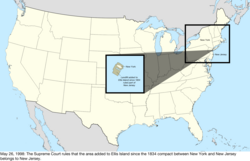 |
| December 31, 1999 | All former Panama Canal Zone parcels not turned over since 1979, as well as all joint canal operations areas, were transferred to Panama. | too small to map |
| January 17, 2001 | The maritime border between the United States and Mexico on the continental shelf in the western Gulf of Mexico beyond 200 nautical miles was defined.[351][447] | no change to map |
| November 24, 2009 | Six islands along the Rio Grande were ceded from Texas to Mexico, and three islands and two bancos were ceded from Mexico to Texas. The transfer, which had been pending for 20 years, was the first application of Article III of the 1970 Boundary Treaty.[351][390][448] | too small to map |
| September 23, 2014 | The maritime border between the United States and Niue was defined.[351][449] The treaty was signed on May 13, 1997, but it was not ratified by the United States until at least 2002, and the United Nations shows it as entering into force on this date.[450] | no change to map |
| January 1, 2017 | The border between North Carolina and South Carolina was clarified following years of surveys and negotiation, moving 19 homes across state lines.[451][452] | too small to map |
| November 30, 2020 | The State of Rhode Island and Providence Plantations adopted a constitutional amendment, renaming itself the State of Rhode Island.[453][454] | 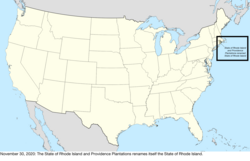 |
Bancos along the Rio Grande

The Banco Convention of 1905 between the United States and Mexico allowed, in the event of sudden changes in the course of the Rio Grande (as by flooding), for the border to be altered to follow the new course.[455] The sudden changes often created bancos (land surrounded by bends in the river that became segregated from either country by a cutoff, often due to rapid accretion or avulsion of the alluvial channel), especially in the Lower Rio Grande Valley. When these bancos are created, the International Boundary and Water Commission investigates if land previously belonging to the United States or Mexico is to be considered on the other side of the border.[456] In all cases of these adjustments along the Rio Grande under the 1905 convention, which occurred on 37 different dates from 1910 to 1976, the transferred land was minuscule (ranging from one to 646 acres) and uninhabited.[457][458][459]
See also

- Geography of the United States
- Territories of the United States
- Historic regions of the United States
- American frontier
- List of U.S. state partition proposals
- List of U.S. states by date of admission to the Union
- Movements for the annexation of Canada to the United States
- National Atlas of the United States
- Ostend Manifesto (annexation of Cuba)
- List of territorial claims and designations in Colorado
- Territorial evolution of Arizona
- Territorial evolution of California
- Territorial evolution of Idaho
- Territorial evolution of Montana
- Territorial evolution of Nevada
- Territorial evolution of New Mexico
- Territorial evolution of North Dakota
- Territorial evolution of Oregon
- Territorial evolution of South Dakota
- Territorial evolution of Utah
- Territorial evolution of Washington
- Territorial evolution of Wyoming
- Territories of the United States on stamps
- List of U.S.–Native American treaties, which indicates tribal land cessions
Notes
References
Further reading
- Rohrbough, M. J. (1978). The Trans-Appalachian Frontier: People, Societies, and Institutions, 1775-1850. Oxford University Press. ISBN 978-0-19-502209-4.
- Stein, Mark (2008). How the States Got Their Shapes. New York: Smithsonian Books/Collins. ISBN 978-0-06-143138-8. OCLC 137324984.
- Van Zandt, Franklin K. (1976). Boundaries of the United States and the Several States: With Miscellaneous Geographic Information Concerning Areas, Altitudes, and Geographic Centers. Washington, D.C.: U.S. Government Printing Office. OCLC 69426475.
- Walker, Francis A. (1874). Statistical Atlas of the United States. [New York] J. Bien, lith. pp. 65–79. Retrieved April 3, 2019.

